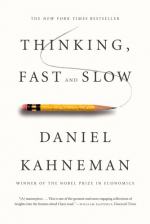
|
1. What is the halo effect?
The halo effect is a cognitive bias wherein the overall impression of a person influences our opinions about his character. The example the author gives is when a charismatic speaker steps to a podium, audiences are more likely to judge his comments favorably.
2. What does the author demonstrate in the first two figures in Chapter 1 (the woman's face and the multiplication problem)?
The differences between System 1 and System 2 thinking. He demonstrates this by indicating that System 1 is the system that attributes the woman in the picture to being angry, whereas the multiplication question demonstrates System 2, which is logical, longer thinking.
3. How does System 1 operate?
System 1 operates automatically and quickly. The thoughts in System 1 require no voluntary control. This system of the mind is considered to be the more intuitive and subconscious of the two.
4. What are the processes of System 2?
System 2 comes into the forefront when System 1 encounters a problem that it cannot calculate. System 2 requires effortful, meaningful attention. This is demonstrated with the multiplication problem in Chapter 1--it requires the brain to stop and calculate and assess.
(read all 60 Short Essay Questions and Answers)
|
This section contains 2,925 words (approx. 10 pages at 300 words per page) |

|




